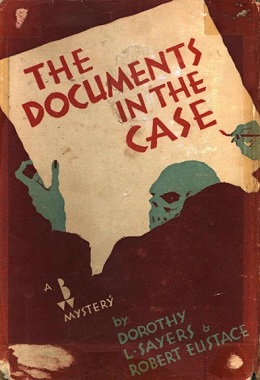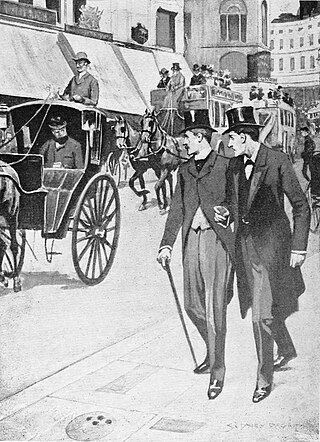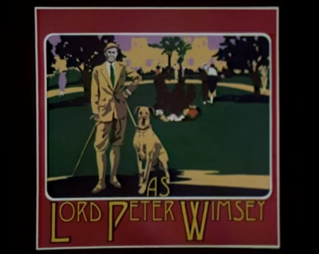
Lord Peter Death Bredon Wimsey is the fictional protagonist in a series of detective novels and short stories by Dorothy L. Sayers. A dilettante who solves mysteries for his own amusement, Wimsey is an archetype for the British gentleman detective. He is often assisted by his valet and former batman, Mervyn Bunter; by his good friend and later brother-in-law, police detective Charles Parker; and, in a few books, by Harriet Vane, who becomes his wife.

Strong Poison is a 1930 mystery novel by Dorothy L. Sayers, her fifth featuring Lord Peter Wimsey and the first in which Harriet Vane appears.

Have His Carcase is a 1932 locked-room mystery by Dorothy L. Sayers, her seventh novel featuring Lord Peter Wimsey and the second in which Harriet Vane appears. It is also included in the 1987 BBC TV series. The book marks a stage in the long drawn out courting of Harriet Vane by Wimsey. Though working closely with him on solving the book's mystery, she still refuses to marry him.

Busman's Honeymoon is a 1937 novel by Dorothy L. Sayers, her eleventh and last featuring Lord Peter Wimsey, and her fourth and last to feature Harriet Vane.

Thrones, Dominations is a Lord Peter Wimsey–Harriet Vane murder mystery novel that Dorothy L. Sayers began writing but abandoned, and which remained at her death as fragments and notes. It was completed by Jill Paton Walsh and published in 1998. The title is a quotation from John Milton's Paradise Lost and refers to two categories of angel in the Christian angelic hierarchy.
Harriet Deborah Vane, later Lady Peter Wimsey, is a fictional character in the works of British writer Dorothy L. Sayers (1893–1957) and the sequels by Jill Paton Walsh.

A Presumption of Death is a 2002 Lord Peter Wimsey–Harriet Vane mystery novel by Jill Paton Walsh, based loosely on The Wimsey Papers by Dorothy L. Sayers. The novel is Walsh's first original Lord Peter Wimsey novel, following Thrones, Dominations, which Sayers left as an unfinished manuscript, and was completed by Walsh. A Presumption of Death is written by Walsh, except for excerpts from The Wimsey Papers.
Mervyn Bunter is a fictional character in Dorothy L. Sayers's novels and short stories. He serves as Lord Peter Wimsey's valet, and served as Wimsey's batman during the First World War. Bunter was partially based on the fictional butler Jeeves, created by P. G. Wodehouse.

The Documents in the Case is a 1930 novel by Dorothy L. Sayers and Robert Eustace. It is the only one of Sayers's twelve major crime novels not to feature Lord Peter Wimsey, her most famous detective character. However, the forensic analyst Sir James Lubbock, who appears or is mentioned in several of the Wimsey novels, also appears in The Documents in the Case.
Sergeant/Inspector/Chief Inspector Charles Parker is a fictional police detective who appears in several Lord Peter Wimsey stories by Dorothy L. Sayers, and later becomes Lord Peter's brother-in-law.

Busman's Honeymoon is a 1940 British detective film directed by Arthur B. Woods. An adaptation of the 1937 Lord Peter Wimsey novel Busman's Honeymoon by Dorothy L. Sayers, Busman's Honeymoon stars Robert Montgomery, Constance Cummings, Leslie Banks, Googie Withers, Robert Newton and Seymour Hicks as Mervyn Bunter.

The gentleman detective, less commonly lady detective, is a type of fictional character. He has long been a staple of crime fiction, particularly in detective novels and short stories set in the United Kingdom in the Golden Age. The heroes of these adventures are typically both gentlemen by conduct and often also members of the British gentry. The literary heroes being in opposition to professional police force detectives from the working classes.

Dorothy Leigh Sayers was an English crime novelist, playwright, translator and critic.

The Attenbury Emeralds is the third Lord Peter Wimsey-Harriet Vane detective novel written by Jill Paton Walsh. Featuring characters created by Dorothy L. Sayers, it was written with the co-operation and approval of Sayers' estate. It was published by Hodder & Stoughton in September 2010.

The Late Scholar is the fourth and final Lord Peter Wimsey-Harriet Vane detective novel written by Jill Paton Walsh. Featuring characters created by Dorothy L. Sayers, it was written with the co-operation and approval of Sayers' estate. It was published by Hodder & Stoughton on 5 December 2013 in the UK, and on 14 January 2014 in North America.

A Dorothy L. Sayers Mystery is a series of television adaptations of three Lord Peter Wimsey novels—Strong Poison, Have his Carcase and Gaudy Night—by Dorothy L. Sayers.
Miss Katharine Alexandra Climpson is a minor character in the Lord Peter Wimsey stories by Dorothy L. Sayers. She appears in two novels: Unnatural Death (1927) and Strong Poison (1930), and is mentioned in Gaudy Night (1935) and Busman's Honeymoon (1937).
Lord Peter Wimsey is a series of full cast BBC Radio drama adaptations of Dorothy L. Sayers's Lord Peter Wimsey detective novels broadcast on BBC Radio 4 between 1973 and 1983, with a further adaptation of Gaudy Night mounted for BBC Audiobooks in 2005 to complete the full sequence of Sayers' novels, all starring Ian Carmichael in the title role.

Lord Peter Wimsey is a series of television serial adaptations of five Lord Peter Wimsey novels by Dorothy L. Sayers, starring Ian Carmichael as Wimsey. They were broadcast on BBC1 between 1972 and 1975, beginning with Clouds of Witness in April 1972.












